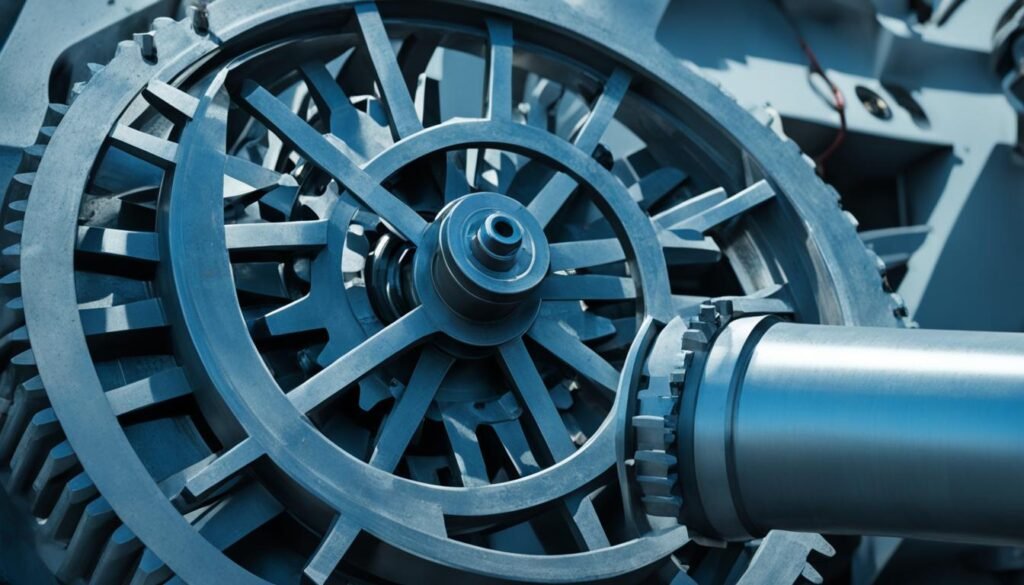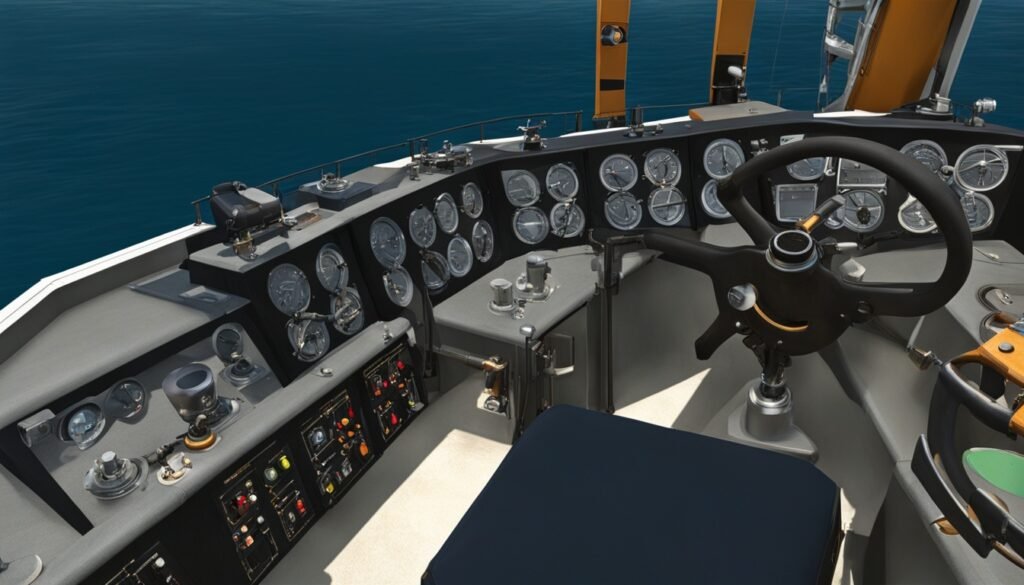I’ve always been drawn to the complex world of ships. The rudder might grab the spotlight, but the steering gear is the real star. It turns the captain’s wishes into smooth turns of a huge cargo ship. Let’s dive into how this system works.
The steering gear in ships has been crucial since the first boats sailed. From manual rudders to today’s marine hydraulics and electro-hydraulic systems, it’s changed a lot. This system is key for ship rudder systems and making ships move easily. Let’s explore this nautical engineering wonder together.

Introduction to Steering Gear Systems
Steering gear systems are key for ships to move and navigate well. They help control the ship’s direction and speed. At the center of these systems are the rudders, which guide the ship’s path. Over time, steering gear has changed a lot to meet new needs in maritime engineering.
Role of Rudders in Ship Maneuvering
Rudders are vital for turning and changing a ship’s direction. By changing the rudder’s angle, the ship can turn smoothly through tight spots. The rudder’s effectiveness is crucial for how well a ship can move and turn quickly.
Evolution of Steering Gear Systems
- Early steering gear was manual, needing a lot of effort to turn the ship.
- As ships got bigger and faster, better steering systems were needed.
- New technology and engineering led to modern steering systems.
- Now, ship control systems and marine tech have changed how ships steer, making them better.
| Steering Gear System | Key Features |
|---|---|
| Hydraulic | Uses hydraulic pumps and actuators Works at high pressure (100-175 bars) Used in larger ships |
| Electro-Hydraulic | Mixes electrical and hydraulic parts Provides precise control Works on different sized vessels |
Steering gear has evolved to improve ship control and navigation. Today, new technologies keep making steering systems better, ensuring safer and more efficient ship operations.

Steering Gear in Ships
The steering gear’s performance depends on key aspects, guided by classification societies. The helm controls the steering, like an automobile’s steering wheel. The control force for turning comes from the helm wheel to the steering gear system.
Types of Steering Gear Systems
Ships use two main steering gear types: electro-hydraulic systems and all-electric systems. Hydraulic-powered units include ram type (2 ram or 4 ram) and rotary vane type systems. The ram-type needs high hydraulic pressure, while the rotary vane uses less.
Central Control and Operation
The steering gear moves the rudder based on bridge signals, controlling the ship’s direction. It’s vital in tight spaces. Emergency controls like the Follow Up (FU) Tiller and Non-Follow Up (NFU) Tiller are available for emergencies.
| Steering Gear System | Key Features |
|---|---|
| Ram Type | Generates high torque with hydraulic oil pressure ranging from 100 to 175 bars |
| Rotary Vane | Operates with lower hydraulic pressure requirements (60 to 100 bars) |

The steering gear system’s central control is key for safe ship maneuvering, especially in tight spaces. Different systems have unique features, ensuring the ship steers well and responds quickly.
Hydraulic and Electro-Hydraulic Steering Gear
Most ships now use advanced electro-hydraulic systems for steering. These systems create hydraulic pressure with pumps powered by electric motors. Actuators are key in turning this pressure into a force that turns the rudder.
Hydraulic Pumps and Actuators
The ship’s steering gear has control systems, powering units, transmission units, and the main steering gear or rudder unit. The telemotor sends electrical signals from the bridge to the rudder unit. The hunting gear mechanism is vital for feedback control, making sure the rudder turns right and stays in place.
Ram Type Steering Gear
The ram-type steering gear is a popular choice for ships. It uses four hydraulic cylinders on the actuator disc’s arms. These cylinders turn the rudder with the hydraulic pressure they create.
Rotary Vane Steering Gear
The rotary vane steering gear is another electro-hydraulic system. It has a fixed housing with two vanes that rotate, creating four chambers. The vanes and housing work together to make the hydraulic pressure needed to turn the rudder.
Companies like Kawasaki and Kobelt have greatly improved electro-hydraulic steering gear systems. They’ve added advanced pumps, feedback control, and digital systems. This makes ship steering more reliable and efficient.
Performance Requirements and Safety Features
Ships need strict rules for their steering gear systems to move safely and effectively. These rules come from classification societies. They cover speed, movement angle, and backup systems.
Classification Society Rules
SOLAS sets the rules for the steering gear. The main gear must turn the rudder 35 degrees each way in 28 seconds. If one power unit fails, it should still turn 15 degrees each way in a minute.
It’s important to have backup systems. Major power units and controls must be duplicated. This prevents the whole system from failing.
There must also be a backup power source for the steering gear. This system should turn the rudder 15 degrees each way in 60 seconds. This ensures the ship can steer in emergencies.
Safematic Design and Fail-Safe Mechanisms
Modern steering gear uses a Safematic design for safety and reliability. It includes automatic valves that can isolate a broken part while keeping the system running. These features prevent losing steering completely, which is crucial for all ships.
Following these rules and using Safematic design makes ships safe and reliable. Ship owners and operators can trust their autopilots and steering systems to work well. This protects the ship and its crew.
You can refer to this blog post for more information on Understanding Steering Gear in Ships
Conclusion
This article has shown how crucial steering gear systems are for safe ship navigation and control. From basic rudder systems to advanced electro-hydraulic ones, steering gear has evolved. It’s shaped by rules, new tech, and the need for reliable, efficient, and easy-to-maintain solutions.
Today, ship bridges often have steering automation. This gives operators better control and lets them maneuver ships precisely. With marine hydraulic actuators, sensors, and computerized units, the steering gear now works better. This means safer, more precise, and cheaper operations.
The maritime industry values safety and sustainability more than ever. Knowing about steering gear and following rules is key. By keeping up with new steering tech, ship owners and operators can keep their ships running well. This helps make the global shipping industry safer and more efficient.
FAQ
What is the role of the steering gear system in a ship?
Rudders control the motion and direction of ships. The steering gear system is key to this, vital since the start of sailing. It’s essential for ship control.
How have steering gear systems evolved over time?
As ships got bigger and faster, new steering systems made steering easier. Now, most ships use electro-hydraulic systems. These systems use electric pumps and actuators to work with the rudder stock.
What are the two main types of steering gear systems used in ships?
Ships use two main steering gear systems: hydraulic and electro-hydraulic.
How is the control force for turning the ship transmitted through the steering gear system?
The ‘control force’ starts at the helm wheel. It goes through the steering gear system. Actuators then turn hydraulic pressure into a force that moves the rudder.
What are the performance requirements for the steering gear system?
The steering gear must turn the ship 35 degrees in each direction in 28 seconds. If one power unit fails, it should turn 15 degrees in each direction in a minute.
Read our other related posts
